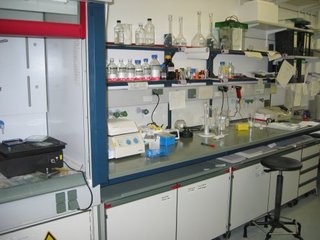Laboratory
|
|
A laboratory (often abbreviated lab) is a place where scientific research and experiments are conducted. A lab can hold space for one to thirty, or more, researchers depending on the size of the room and state mandated maximum occupancy limit.
All laboratories share some common features, mainly Laboratory equipment and Laboratory glassware: Usually, they have at least one fume hood. Toxic and hazardous chemicals can be safely handled in a fume hood. This reduces, and usually eliminates, the risk of inhalation of toxic gases produced by the reaction of chemicals. Laboratories usually have a sink for handwashing. A fire extinguisher is located in a laboratory, as well as a fire blanket, to help exterminate fire in the event of an accident. There is also an eye wash station and an overhead shower in the event that chemicals gain access onto clothes, skin, or eyes.
Supporting the laboratory is usually a stock room, or preperation room, where dry and wet chemicals are stored. This stockroom prepares all the reagents (acids, bases, buffers) of various quantities and concentrations, as well as orders and distributes supplies (glassware, chemicals, personal protective equipment) to the laboratory.
When researchers perform experiments in the laboratory they use pure phases and sterile reagents. Impure chemicals undergo purification first, then are used in an experiment; non-sterile reagents are first autoclaved before use. Impure, and non sterile reagents interfere with experiments causing undesired results.
The equipment and orientation of a laboratory will ultimately depend on its purpose. University laboratories, as well as chemistry and biochemistry laboratories will contain myriad glassware. In these laboratories, general experiments will be performed to isolate or purify compounds, or perform research to gain new knowledge on a given compound or scientific idea.
Other common laboratory equipment includes centrifuges to remove solid particles from a liquid, or create a density gradient, spectrophotometers to accurately measure the optical absorbance of a liquid and a particular wavelength (measure its colour), aspirators for providing suction, and water baths that maintain a substance at a particular temperature.
While there is a typical set of glassware used for conducting various experiments, other laboratories have different requirements and arrangements.
Microbiology laboratories usually have separate rooms with negative pressure to prevent the breathing in of harmful bacteria. Air is often passed through a number of filters and then repumped into the room.
Laboratories designed for processing specimens, such as environmental research or medical laboratories will have specialised machinery (automated analysers) designed to process many samples and numerous tests. Research and experimentation is not a priority in these laboratories; the aim is to give a fast and reliable result.
Laboratory Safety
While laboratories differ in purpose and function, safety is always a key issue.
Below is a list of standard, good laboratory practices:
- Wear goggles or safety glasses at all times.
- Wear gloves.
- Wear a safety apron where appropriate.
- Do not eat or drink while in the laboratory (i.e. accidental ingestion of dangerous chemicals).
- Consider all laboratory chemicals to be a hazard: do not taste, eat, or drink any chemical in the laboratory.
- Read and understand experiment procedures before beginning any experiment.
- Dispose of chemicals properly (the sink is generally not the correct place).
- Ensure gas lines are shut off before leaving the laboratory.
- Do not attempt to undertake experiments or procedures unless a trained chemist or scientist is present.

